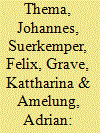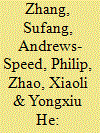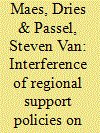|
|
|
Sort Order |
|
|
|
Items / Page
|
|
|
|
|
|
|
| Srl | Item |
| 1 |
ID:
124504


|
|
|
|
|
| Publication |
2013.
|
| Summary/Abstract |
The European electricity market is linked to a carbon market with a fixed cap that limits greenhouse gas emissions. At the same time, a number of energy efficiency policy instruments in the EU aim at reducing the electricity consumption. This article explores the interactions between the EU's carbon market on the one hand and instruments specifically targeted towards energy end-use efficiency on the other hand. Our theoretical analysis shows how electricity demand reduction triggered by energy efficiency policy instruments affects the emission trading scheme. Without adjustments of the fixed cap, decreasing electricity demand (relative to business-as-usual) reduces the carbon price without reducing total emissions. With lower carbon prices, costly low emission processes will be substituted by cheaper high emitting processes. Possible electricity and carbon price effects of electricity demand reduction scenarios under various carbon caps are quantified with a long-term electricity market simulation model. The results show that electricity efficiency policies allow for a significant reduction of the carbon cap. Compared to the 2005 emission level, 30% emission reductions can be achieved by 2020 within the emission trading scheme with similar or even lower costs for the industrial sector than were expected when the cap was initially set for a 21% emission reduction.
|
|
|
|
|
|
|
|
|
|
|
|
|
|
|
|
| 2 |
ID:
125724


|
|
|
|
|
| Publication |
2013.
|
| Summary/Abstract |
This paper analyzes China's policy approach to renewable energies and assesses how effectively China has met the ideal of appropriate interactions between renewable energy policy and renewable energy industrial policy. First we briefly discuss the interactions between these two policies. Then we outline China's key renewable energy and renewable industrial policies and find that China's government has well recognized the need for this policy interaction. After that, we study the achievements and problems in China's wind and solar PV sector during 2005-2012 and argue that China's policy approach to renewable energies has placed priority first on developing a renewable energy manufacturing industry and only second on renewable energy itself, and it has not effectively met the ideal of appropriate interactions between renewable energy policy and renewable energy industrial policy. Lastly, we make an in-depth analysis of the three ideas underlying this policy approach, that is, the green development idea, the low-carbon leadership idea and indigenous innovation idea. We conclude that Chinas' policy approach to renewable energies needs to enhance the interactions between renewable energy policy and renewable energy industrial policy. The paper contributes to a deeper understanding of China's policy strategy toward renewable energies.
|
|
|
|
|
|
|
|
|
|
|
|
|
|
|
|
| 3 |
ID:
111460


|
|
|
|
|
| Publication |
2012.
|
| Summary/Abstract |
This paper assesses unintentional interference between different public policies promoting energy efficiency and renewable energy. The paper develops a methodology to study the interference by analysing the economic and technical behaviour of a hybrid energy system. The hybrid energy system in this case consists of an existing cogeneration unit extended with a new installation of thermal solar panels. This puts two complementary heating technologies in juxtaposition. The two technologies are supported with distinct regional support instruments in each region. The design and operation of the energy system is optimised from the point of view of the investor according to the different support instruments. The optimal configuration is analysed as well as its effect on reduced CO2-emissions during the lifetime of the project. The methodology is applied to a case-study for two neighbouring regions, the Netherlands and Flanders. The policies in the Netherlands show a beneficial synergy. In Flanders, the hybrid energy system is not interesting, indicating unbalanced high support for cogeneration in this case. From the point of view of the authorities, a more balanced regional policy as in the Netherlands provides a larger CO2-emission reduction for a smaller cost.
|
|
|
|
|
|
|
|
|
|
|
|
|
|
|
|
| 4 |
ID:
162278


|
|
|
|
|
| Summary/Abstract |
Governments must increase bioenergy use to realise the Paris agreement ambition. Most countries have limited biomass resources and policy goals beyond carbon reduction. This can lead to policy incoherence. Previous studies tended to focus on one end-use sector or on optimising CO2 reduction. This study goes beyond optimisation approaches and investigates cross sector impacts of bioenergy policy proposals via simulation methods for policy proposals in Ireland. As an EU member with ambition for increased bioenergy use, Ireland is a useful case to examine trade-offs. Using the BioHEAT policy decision support tool (Durusut et al., 2018) we find policy in the heat and transport sector close the gap to Ireland's 2030 climate targets by 3%. Policy supporting co-firing of biomass with fossil-fuel to produce electricity increases emissions by 8.3 MtCO2 overall and reduces the policy impact on national climate targets by 63%. Co-firing uses more of the available biomass resources and this limits renewable uptake in the heat sector. Coal conversions and the use of advanced biofuels are found to rely on high availability of imports. Policy supporting biomass use in the power sector may make national climate targets less achievable for EU countries.
|
|
|
|
|
|
|
|
|
|
|
|
|
|
|
|
| 5 |
ID:
105760


|
|
|
|
|
| Publication |
2011.
|
| Summary/Abstract |
We show that renewable energy contributes to Europe's 2020 primary energy savings target. This contribution, which is to a large extent still unknown and not recognized by policy makers, results from the way renewable energy is dealt with in Europe's energy statistics. We discuss the policy consequences and argue that the 'energy savings' occurring from the accounting of renewable energy should not distract attention from demand-side energy savings in sectors such as transport, industry and the built environment. The consequence of such a distraction could be that many of the benefits from demand-side energy savings, for example lower energy bills, increase of the renewable energy share in energy consumption without investing in new renewable capacity, and long-term climate targets to reduce greenhouse gas emissions by more than 80%, will be missed. Such distraction is not hypothetical since Europe's 2020 renewable energy target is binding whereas the 2020 primary energy savings target is only indicative.
|
|
|
|
|
|
|
|
|
|
|
|
|
|
|
|
| 6 |
ID:
088023


|
|
|
|
|
| Publication |
2009.
|
| Summary/Abstract |
This paper examines the economic, environmental and distributional impacts of an idealised tradable white certificate (TWC) scheme and shows how the impacts are modified when the scheme operates in parallel with the EU emissions trading scheme (EU ETS). It uses simple graphical techniques to assess whether a TWC scheme will increase, decrease or have an ambiguous effect on electricity demand, wholesale and retail electricity prices, carbon emissions and investment in energy efficiency, paying particular attention to the interpretation of 'additionality'.
Following a comparable analysis of the impact of the EU ETS, the paper examines the implications of introducing a white certificate scheme in a country that is already participating in the EU ETS. It compares the effect of this combination of instruments to that of the EU ETS operating in isolation. It concludes that there is no necessary link between the price of white certificates and marginal cost of energy efficiency investment, the price of electricity or the ability of the suppliers to eliminate free riders from their subsidy schemes. Also, a TWC scheme will make no contribution to reducing global carbon emissions unless and until it leads to a tightening of the EU ETS cap.
|
|
|
|
|
|
|
|
|
|
|
|
|
|
|
|
|
|
|
|
|